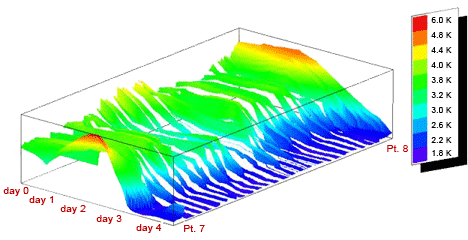CERN, the coolest place in the Universe
“CERN's big chill” - it could be the sensational title of a science-fiction novel, but it's actually a sensational scientific reality! At the beginning of April, a 3.3-km section of the Large Hadron Collider (LHC) was cooled to a chilly ‑271°C, just a couple of degrees above the lowest temperature possible, absolute zero, and colder than outer space! Sector 7-8 (an eighth of the accelerator) thus becomes the world's largest superconducting installation cooled by superfluid helium.
This great achievement is just a prelude to an even greater one, the start-up of the LHC. The LHC will be the world's most powerful accelerator, designed to answer fundamental questions about the elementary components of matter, the forces that bind them together and the evolution of the Universe.
The whole 27-km LHC ring has to be brought down to this super-cool temperature for the accelerator's magnets to operate in a superconducting state. This will enable them to generate a magnetic field that is sufficiently powerful to bend and focus the proton beams accelerated at close to the speed of light. The cooling will be achieved by placing the 1740 superconducting magnets inside a unique “freezer” – the cryogenic system.
The system to cool the 4700-tonne sector 7-8 was commissioned in three stages. The sector was first cooled to 80 K (‑193°C) using 1200 tonnes of liquid nitrogen. At this temperature, the materials contracted under the effect of the cold to 90% of their final level of contraction, which means that the metallic structures become shorter by 3 millimetres per metre. Over the entire 3.3-km sector the structure contracted by nearly 10 metres! Bellows and other such devices are installed between the magnets to offset this effect. The second phase consisted of cooling the sector to 4.5 K using gigantic freezing devices and 15 tonnes of liquid helium.

The magnet temperature profile along sector 7-8 during the cool down.
Whittling the temperature down by a further three degrees was the greatest challenge of all. During the final phase of cooling, a complex pumping system is applied to the bath of bubbling helium. At 4.5 K (‑269°C) and atmospheric pressure, helium is close to its boiling point, the temperature at which it passes from a gaseous to a liquid state. Using the pumps, the pressure is reduced from 1000 millibars (atmospheric pressure) to just 15 millibars, and since temperature falls in proportion to pressure the magnets are cooled right down to 1.9 K (‑271°C). At this temperature helium becomes superfluid and develops the most remarkable properties, flowing with virtually no viscosity and allowing greater heat transfer capacity.
The seven other sectors of the LHC will be commissioned in the coming months, each taking their turn to be cooled close to absolute zero.
24 April 2007

